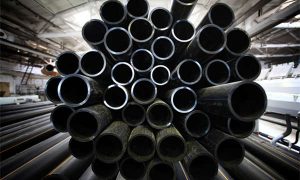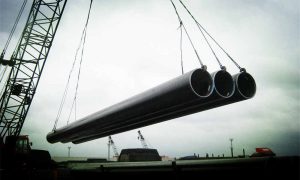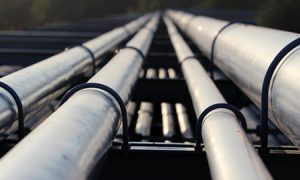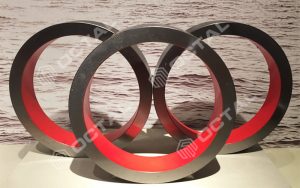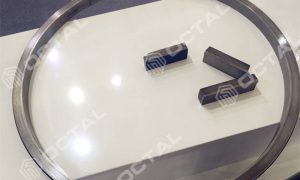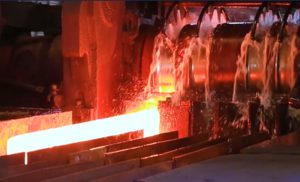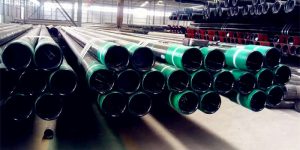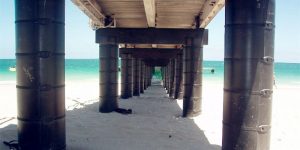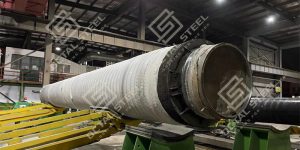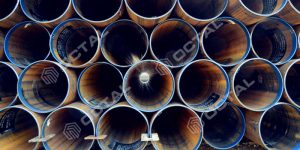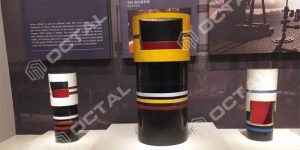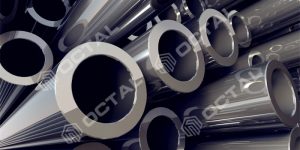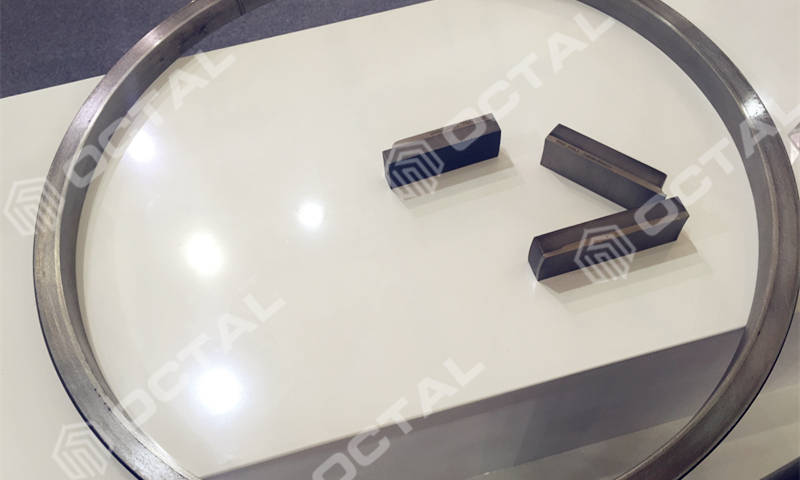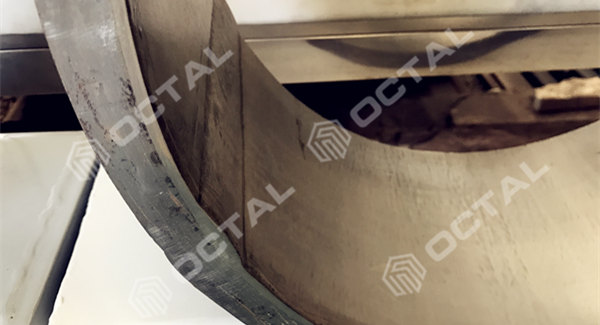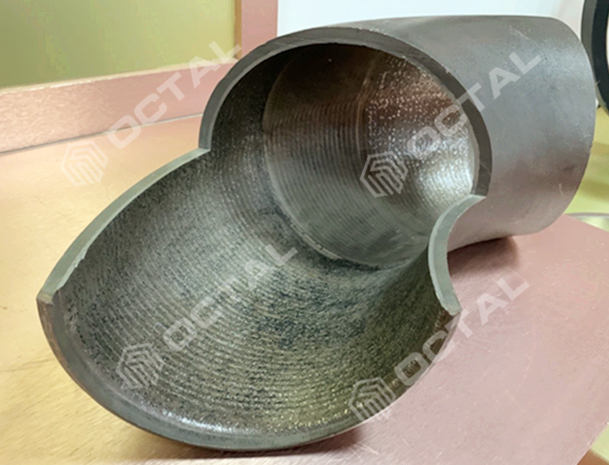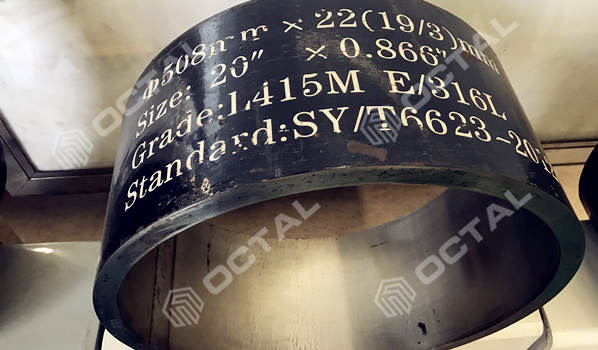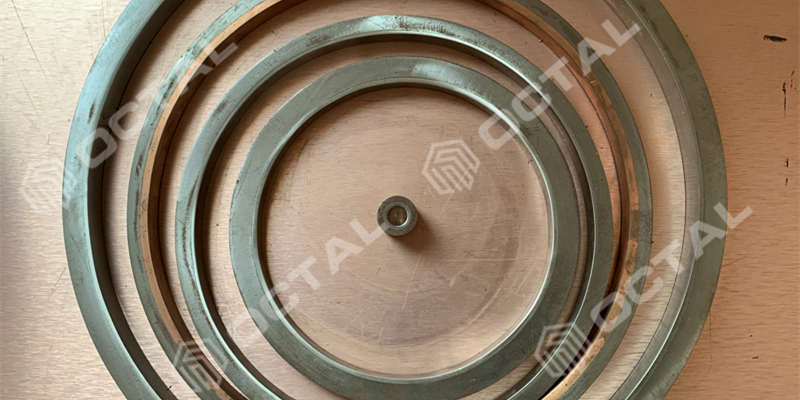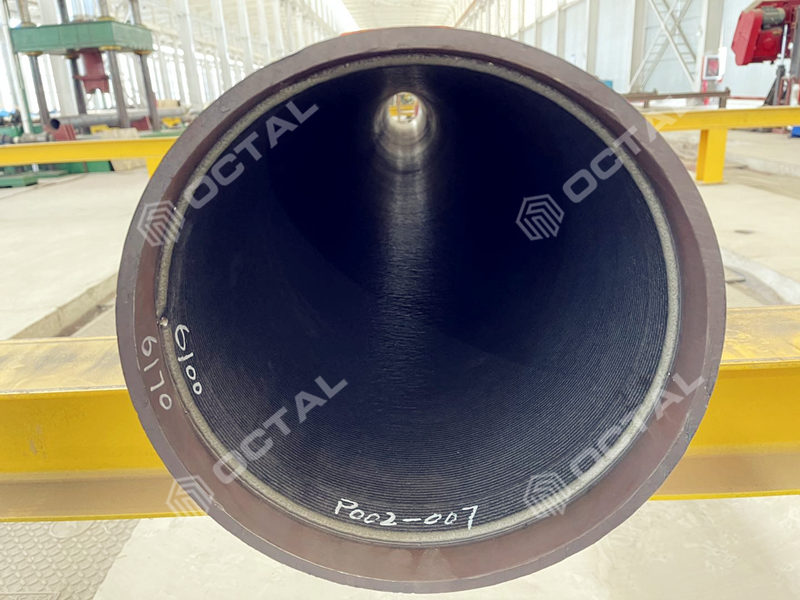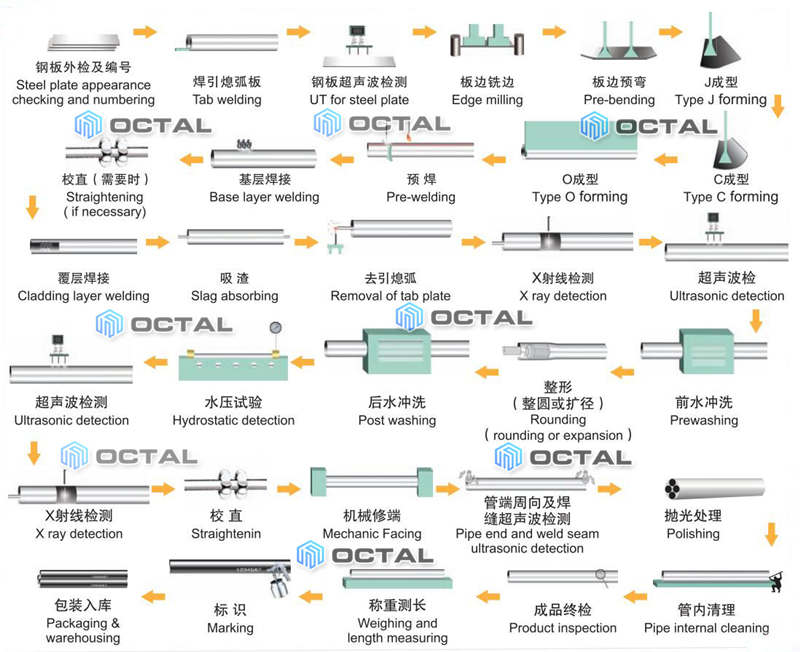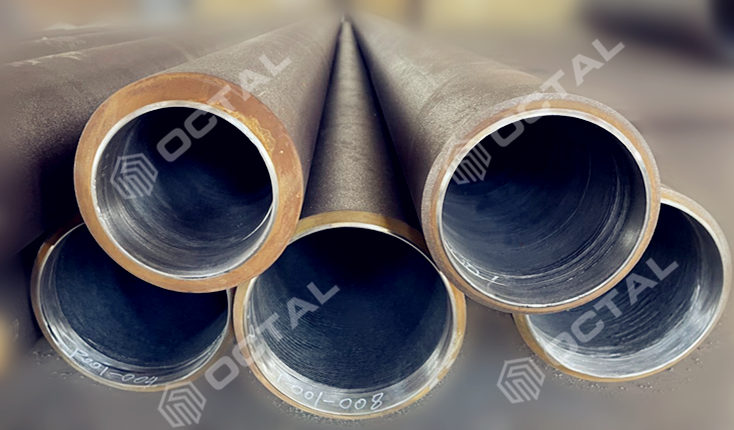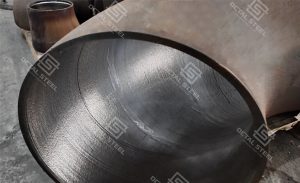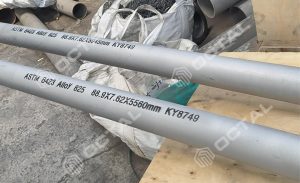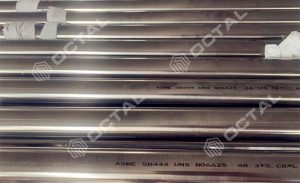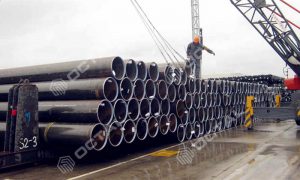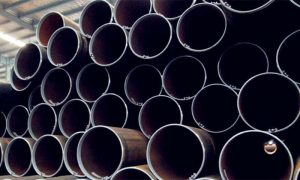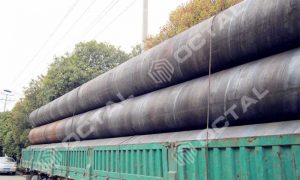CRA Clad and Lined pipe
CRA cladding or lining material options in:
Stainless material in 304, 304L, 316, 316L, 310S, 317L, 321
Alloy Steel Material in Incoloy Alloy 825 (UNS N08825) , Inconel Alloy 625 (UNS N06625), S31803, S31254
Hastelloy Material C276, (B575 N10276), C22, etc.
External with bonding with Carbon Steel Pipe in API 5L B to X80, or ASTM A106 B, ASTM A333 Grade 6 etc.
CRA (Corrosion-Resistant Alloy) clad and lined pipes are engineered solutions developed for use in highly corrosive oil and gas environments, where standard carbon steel pipelines cannot withstand aggressive media such as CO₂, H₂S, or chlorides. These pipes are considered a new-generation material in modern pipeline systems, combining two different metals through advanced bonding or cladding processes to achieve both mechanical strength and corrosion resistance.
In this composite structure, the inner layer (CRA layer) is made from premium corrosion-resistant alloys such as stainless steel 316L, Inconel 625, or other nickel-based alloys, providing excellent protection against internal corrosion. The outer layer (base pipe) is fabricated from cost-effective carbon steel, typically conforming to API 5L, ASTM A106/A53, or ASTM A333 Grade 6 standards, ensuring high tensile strength and pressure-bearing capacity.
Together, these materials create a dual-layer system that offers the structural integrity of carbon steel and the corrosion resistance of high-performance alloys—making CRA clad and lined pipes ideal for offshore pipelines, sour gas fields, and subsea flowlines where long-term durability is essential.
Clad and lined pipes are specialized types of pipes designed to enhance corrosion resistance and improve performance in various applications. Here’s a brief overview:
Clad Pipes:
Clad pipes are composite pipes produced by metallurgically bonding a layer of corrosion-resistant alloy (CRA), such as stainless steel, Inconel, or Incoloy, to a carbon steel base pipe. This dual-layer structure combines the mechanical strength and pressure capacity of carbon steel with the superior corrosion resistance of the CRA layer.
Cladding can be achieved through several methods, including explosive bonding, weld overlay, or hot roll bonding, depending on project requirements and alloy selection. The resulting clad pipe provides long-term durability and reduced maintenance costs in demanding service conditions.
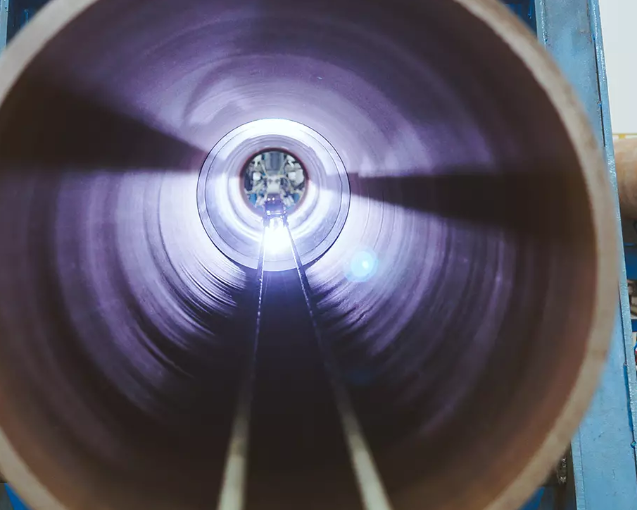
Applications:
Clad pipes are widely used in oil and gas production, subsea pipelines, refineries, chemical processing plants, and power generation facilities, where exposure to CO₂, H₂S, chlorides, and other corrosive media poses a significant risk to standard carbon steel pipelines.
They are particularly suitable for:
-
Offshore and subsea flowlines transporting corrosive fluids.
-
Sour service pipelines containing H₂S or acidic components.
-
Refinery and petrochemical piping systems requiring enhanced corrosion resistance.
-
High-pressure and high-temperature service environments (HPHT).
By combining strength, cost efficiency, and corrosion protection, CRA clad pipes deliver reliable performance and extended service life in aggressive operational conditions.
Clad Pipe Fittings:
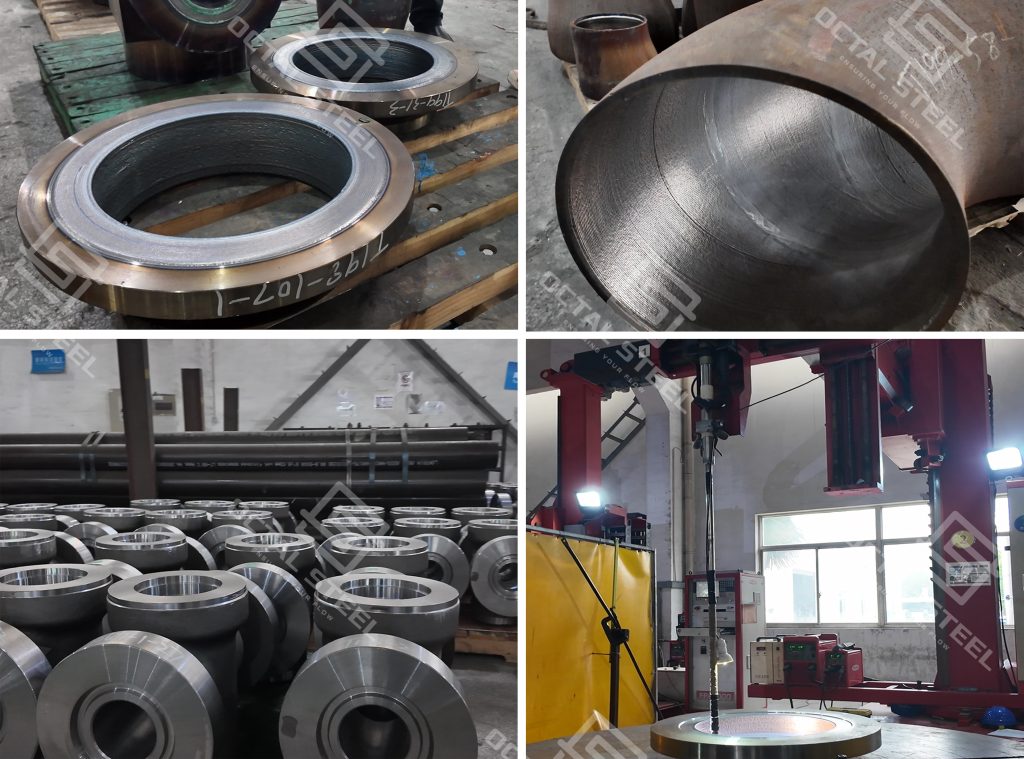
In addition to CRA clad and lined pipes, clad pipe fittings are essential components used to connect and integrate these corrosion-resistant pipelines into complete flowline systems. These fittings are designed and fabricated with the same corrosion-resistant alloy (CRA) layer and carbon steel base material combination, ensuring uniform performance and corrosion protection throughout the pipeline.
Common types of CRA clad fittings include:
-
Clad elbows (45° / 90° / 180°) – for directional changes in pipeline routing.
-
Clad tees and crosses – for branch connections and flow distribution.
-
Clad reducers (concentric and eccentric) – for transition between different diameters.
-
Clad caps and stub ends – for pipe closure or connection to flanged joints.
-
Clad flanges (weld neck, slip-on, blind, etc.) – for secure bolted connections with matching corrosion-resistant faces.
These fittings are manufactured according to ASTM A234 / ASME B16.9 standards for seamless or welded fittings, with CRA layers typically made of 316L, 317L, 904L, Inconel 625, Incoloy 825, or Duplex stainless steel. The cladding process may involve explosive bonding, weld overlay, or roll bonding, depending on project requirements.
CRA clad fittings are widely used in sour service, offshore production facilities, subsea flowlines, and refineries, where corrosion resistance and mechanical integrity are equally critical. Combined with Octal Steel’s CRA clad pipes, they provide a complete corrosion-resistant pipeline solution for high-pressure, high-temperature, and chemically aggressive service conditions.
Lined Pipes:
- Definition: Lined pipes have a protective lining (often made of materials like PTFE, rubber, or other polymers) applied to the inner surface of the pipe. This lining acts as a barrier against corrosive substances.
- Applications: Frequently used in applications involving the transport of aggressive chemicals, slurries, or other materials that could damage the pipe’s interior.
Key Differences:
- Construction: Clad pipes have a bonded outer layer, while lined pipes have a separate inner lining.
- Purpose: Clad pipes are designed for structural integrity and corrosion resistance, while lined pipes focus primarily on protecting the inner surface from corrosive materials.
CRA clad pipe and lined pipe application
CRA clad and lined pipe generally used in petroleum industries for special working conditions like corrosion or severe temperature environment. For on shore and off shore pipeline systems, there are often contain the high S, H2S, and CO2 chemicals in the transportation fluids. When these values reached a certain content it will make a big corrosion to the pipelines in Carbon and Manganum steel material like API 5L pipes and ASTM A106 pipes. In this case, the CRA clad and lined pipe is applied for this.
CRA Pipe Advantages
CRA material combined with carbon steel material, it is a great achievement for both the mechanical strength (Tensile and Yield strength), meanwhile to have the excellent corrosion resistance performances. No matter on the pipe personality or to save in economic purposes, clad and lined pipe is a perfect choice.
For manufacturing process of CRA clad or lined pipe, there are many bonding methods to mix CRA layer on the steel pipe:
CRA Lined Pipe Mechanical bonding: With machine power pressure or with water pressure;
CRA Clad Pipe Metallurgical bonding: Use exposive power to clad plate comined with steel plate.
CRA Clad Pipe Welding overlay: Use welding rod (stainless or alloy steel welding rod) to weld a certain thickness on pipe internal surface.
Amoung those types the best performances for bonding is to use welding overlay, but the cost is also the highest, as it takes very slow for welding processes.
Mechanical lined type
CRA weld overlay type
Clad pipe manufacturing process
The point of manufacturing of clad pipe is using metallurgical ways to create the bond. With below manufacturing options:
CRA Clad pipe with exposive power: Use explosive power to clad internal alloy steel pipe to the external carbon steel pipe.
Welding Overlay CRA Clad Pipe: Use welding methods to welding alloy steel rod on the carbons steel pipe.
CRA Clad Steel Plate to weld to CRA pipe: By explosive power to clad alloy steel plate to carbon steel plate, then use LSAW welding process to manufacture plate to CRA Pipe.
Inconel alloy 625 weld overlay / Alloy 625 Cladding / CRA 625 – Popular CRA pipe
Inconel alloy 625 is a non-magnetic, corrosion and oxidation resistant, Ni-Cr based solid solution strengthened deformed superalloy. Nickel alloy 625 is nickel-chromium-molybdenum-columbium alloy, major content Nickel miniumum 58%, also called Inconel 625 or UNS NO6625. Other chemical content Chromimum 20% to 23%, Columbium + tantalum 3.15% to 4.15%, Molybdenum 8.0% to 10.0%, columbium Cobalt allow 1.0% max if determined, Iron 5.0% max.
Inconel 625 is extremely resistant to a variety of unusually severe corrosive environments, including high temperature effects such as oxidation and carburization, including corrosion. Because of the solid solution of the refractory Co and Mo in a Nickel-Chromium matrix, provides 625 an outstanding strength and toughness in high temperature ranging from low up to 2000°F (1093°C).
Use weld overlay cladding methods to clad inconel alloy 625 or alloy 825 material inside of the carbon steel pipe has been a popular option not only solve the corrosion resistant problem to suit different severe environments, but also provides a high strength performances with save a large of cost.
Lined pipe manufacturing methods
For lined pipe is to create through a mechanical bond on the carbon steel pipe. (Put CRA pipe internal to connect to external C-Mn steel pipe through mechanical procedures)
Here are options to manufacture the CRA lined pipe:
Option 1 with external carbon steel seamless pipe internal alloy welded pipe: Outer Pipe (Backing Steel Pipe) Inspection – Cutting – Machining Backing Steel Pipe – Cleaning Inner Surface – Assembling Inner Alloy Pipe – Hydro forming – Cutting Lined Pipe Ends – Beveling – Welding – Sizing pipe End – Forming – RT – ET & Endoscope – Ultrasonic Test – PT – Measuring Size and Inspection – Marking – Packing
Option 2 wtih CRA lined or clad steel plate: Mechanical lined or cladded Steel Plate Checking – UT for Lined Steel plate – Plate Beveling – Preforming – Forming to Pipe (JCOE) – Welding – Rounding – Hydrastatic test – Beveling pipe end – X Ray Test- Ultrasonic Test – Size Inspection and Measuring – Marking – Packing and Storage
Another bonding process of CRA steel pipe is to use a Full-Length Pipe Expander than to use Hydroforming machine. (Between two options a Full-Length-Pipe-Expander is better for bonding CRA material for lined pipe)
Octal supplied CRA clad pipe and lined pipe in below specification
We supply CRA Clad and Lined pipes, Fittings, Flanges:
Clad or Lined standard: API 5LD, API 5LC
Outer Diameter Cladding pipe: 6” to 60”
OD range for CRA lined pipe: 1/2” to 24”
Thickness: Up to 80 mm (Clad pipe), 7 mm to 35 mm (For lined pipe)
Maximum length: 12.3 meter
Backing steel pipe (mother pipe) material: Carbon Steel Pipe, C-Mn Steel Pipe, API 5L B, X42, X46, X52, X56, X60, X65, X70, X80 PSL1, PSL2 and SOUR NACE MR0175, ASTM A106 B, ASTM A333 Grade 6, etc.
CRA Clad Pipe Fittings: Elbow, Cap, Tee, Reducer in ASME B16.9, Material in ASTM A234WPB, WPC, ASTM A420 WPL6.
CRA Clad Flange: Welding Neck Flange, Slip On Flange in ASME B16.5, B16.47 A/B, Material in ASTM A105, A350.
Cladding and Lining CRA (Corrosion resistant alloy) material: Austenitic stainless steel, nickel alloy steel, Hastelloy C276, alloy 625, 825, S31803, S31254 titanium alloy steel duplex steel, and etc.
More over, We are also capable to supply clad pipe fittings and flanges.
CRA Clad or Lined Pipe Order Sample Description & Specification
CRA Clad or Lined Steel Pipe, Carbon steel pipe in ASTM A106 Grade B, Outer Diameter 16 in, Nominal Weight 62.58 lb/ft, Wall thickness Schedule STD. Inner Coating Lining or Cladding HASTELLOY C276 in Thickness 0.125 in / 3mm, External Coating Varnished, Nominal Length 12 Meter (40 FT), Ends Beveled.
Sample Description for Cladding Pipe Fittings Order
Eccentric Reducer, Material Carbon Steel, Standard and Grade ASTM A234 WPB, Ends Design Beveled.
Nominal Diameter 18 in x 16 in, Wall Thickness Sch 40. ASME B16.9 manufacturing standard, External Paint Anti-Corrosion Coating, Internal Coating Cladding 1/8”/3mm thick B575 N10276.
Ensuring Durability in Corrosive Pipeline Applications
CRA clad & lined pipe solutions strike a strategic balance between mechanical strength and corrosion resistance, making them ideal for pipelines handling sour gas, high-chloride water, CO₂ injection, saltwater reinjection, and other aggressive fluids. Their dual-material design ensures both long-term structural integrity and protection against internal corrosion.
Octal Steel provides a full range of CRA clad and lined pipes, fittings, and flanges, compliant with API 5LD, API 5L, ASTM, and ASME standards. Our supply includes outer diameter ranges from 6″ to 60″ (clad) and ½″ to 24″ (lined), with CRA thickness up to 80 mm (clad) and 7–35 mm (lined), and complete documentation (MTC, NDT reports, bond strength certificates). Octalsteel
For pipeline projects demanding both anti-corrosion performance and structural reliability, choosing Octal Steel’s CRA clad & lined pipe portfolio means investing in engineered longevity and operational assurance.
Social Share
